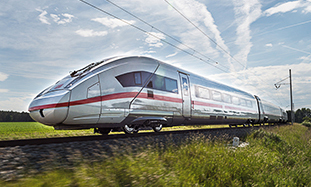Deutsche Bahn honors Siemens as most innovative supplier
Posted: 21 September 2016 | | No comments yet
Deutsche Bahn honored Siemens today as its most innovative supplier. Siemens was recognised for its development of a completely new vehicle concept that offers great operating flexibility…


Deutsche Bahn honored Siemens today as its most innovative supplier. The Supplier Innovation Award was presented by Rüdiger Grube, CEO of Deutsche Bahn (DB), for the new Intercity ICE 4.


Siemens was recognised for its development of a completely new vehicle concept that offers great operating flexibility. With this concept, DB can easily adapt to changing route requirements and passenger needs over the train’s entire lifecycle.
“The ICE 4 marks the development of a new vehicle concept that combines a number of innovative technologies and processes and is distinguished by flexible train configurations and optimised interior space,” commented Rüdiger Grube in his laudatory speech.
“To provide the flexible vehicle concept, the principle of individual cars for a multiple-unit train was rigorously implemented for the first time. The “power car principle” is an absolute innovation in high-speed rail: The so-called “power car” combines all traction components in one car. Trainset configurations from 5 cars to 14 cars are possible by combining unpowered trailer cars with power cars,” explained Jochen Eickholt, head of Siemens’ rail business.
Each power car contains all traction components under the floor. The two end cars and the obligatory multifunctional car, responsible for functions like the passenger information system, can be combined with the desired number of intermediate cars, with or without power. This flexibility is made possible by Siemens newly developed Sibas PN train control system that is being used for the first time in the ICE 4. In contrast to previous trains in which the controls of all cars are interconnected, each car operates autonomously, enabling a flexible combination of individual cars. In this system, the autonomous car controls only handle functions in the respective car. At the same time, the car controls are integrated into the train communication network. The central controls are located in the end cars. This flexibility allows DB to scale the train to meet speed and passenger capacity requirements. Homologation of the train was also largely flexible. For example, homologation was received for an individual car that is operated in a fixed train configuration. If the configuration is changed, only a manageable number of certificates for the specific overall train have to be furnished. Moreover, a so-called “mass range” was also approved: This gives DB the possibility to make weight-relevant changes, such as in the interior, within given limits without having to renew the homologation.
The ICE 4 uses less energy than its predecessors. A raised roofline the length of the train and a lower, streamlined roof on the end cars improve the aerodynamics and lower wind resistance. The light, internally supported bogies and weight-optimised traction bogies reduce the train’s weight. Overall, a 12-car ICE 4 reduces energy consumption by around 22 percent per seat in comparison to the ICE 1.
As a result of the extended car bodies, the ICE 4 has one less car for a train length of 200 meters. This lowers investment and maintenance costs, reduces the number of connecting corridors, provides more usable interior space and improves aerodynamics. The complete interior furnishings are modular and flexible. The seats can be flexibly installed in rails on the floor and have integrated features to enhance passenger comfort. This enables DB to quickly respond to changing capacity requirements. A separate bicycle compartment is also provided.
The train’s new interior accent lighting offers greater comfort and an enjoyable experience for passengers. The parameter-controlled interior lighting adjusts to natural lighting conditions and can thus have a positive effect on the human organism. The lights are automatically regulated according to the season and time of day.
The ICE 4 will be the backbone of DB’s future long-distance network. In May 2011, Deutsche Bahn signed a framework agreement with Siemens as general contractor for up to 300 trainsets. I30 ICE 4 trains were ordered in the first step. Siemens developed the innovative vehicle concept and is responsible for the project management and homologation, the design and production of all electronics as well as the traction bogies, the design of the complete interior furnishing, and for the production of around two-thirds of the cars. The development and production of all shells and the internally supported bogies, as well as the production of around one-third of the cars are the responsibility of Bombardier Transportation as the key supplier.


